Castles and palaces are usually accompanied by smaller outbuildings, which are given a special name in Austrian areas: Stöcklgebäude. Such a building also stood next to the Baroque Royal Palace in Buda, which was demolished at the turn of the last century. However, it remained in his name as it was carried forward by the ornamental staircase built in its place. The western side of the Castle has been surrounded by walls since the Middle Ages, which was transformed into a court with a representative appearance at the turn of the century. Our imaginary journey begins on the Palota Road, which borders the western side of the Castle, and passes through this court, so that its end point - and its climax - be the decorative staircase.
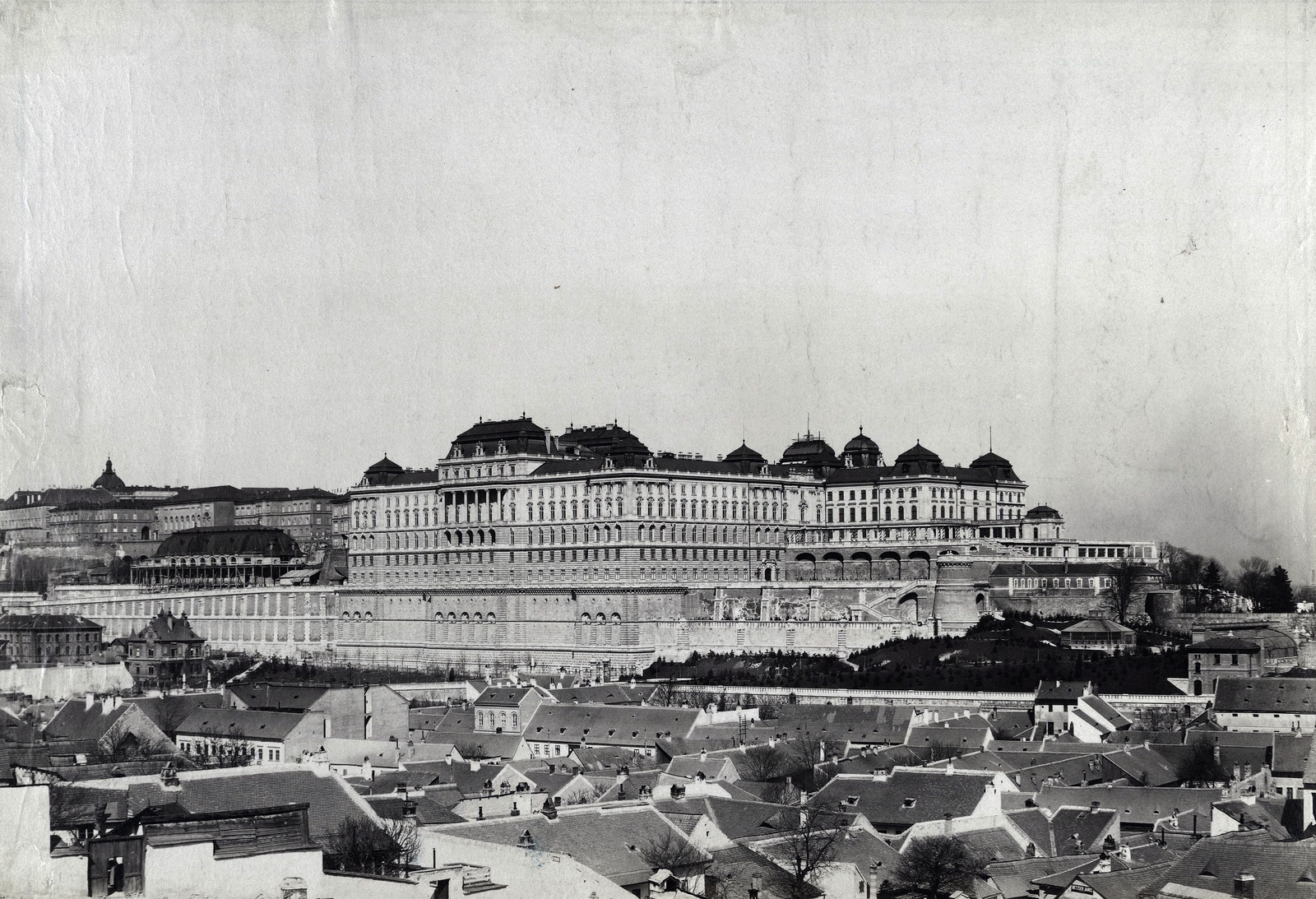
The Royal Palace seen from Tabán around 1900 (Source: Budapest Archives / photographs by György Klösz. Reference No.: HU.BFL.XV.19.d.1.08.093)
From the middle of Palota Road - just above the Chain Bridge Tunnel - branches Lovarda utca, which runs at the bottom of the historical castle wall and widens into the said yard, the Csikós Court. The name comes from a statue of György Vastagh Jr. entitled Lovát fékező csikós [Horse-herdsman Restraining His Horse], which won the gold medal at the 1900 Paris World's Fair and proclaimed the function of the Royal Riding Hall in the courty in the beautiful language of art. The building, completed in 1902, was demolished in 1950, because of World War II damage, and the yard itself was closed to traffic. The accessibility of the castle was allegedly made more difficult because, after the reconstruction, Mátyás Rákosi and his people's commissioners wanted to move into the royal palace, whose security would have been guaranteed.
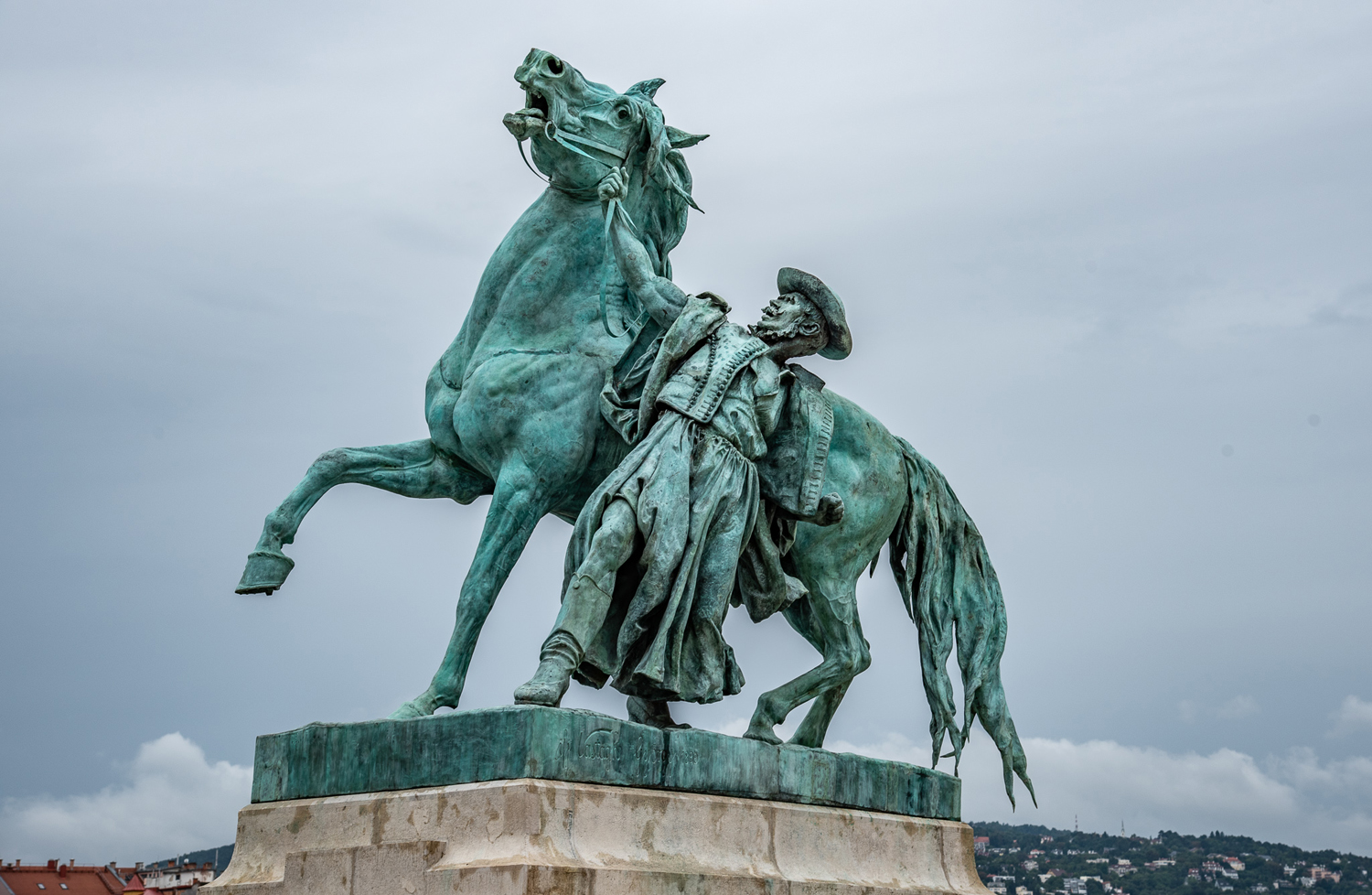
György Vastagh Jr.: Lovát fékező csikós (Photo: Balázs Both / pestbuda.hu)
The Csikós Court, reopened this year, is bordered by the Riding Hall on Palota Road, which stands on top of a robust retaining wall reminiscent of castles. This masonry is also worthy of a king, its surface covered with red bricks is bordered by a stone frame, and the support pillars for reinforcement are also made of large freestones. Its most beautiful ornament is the coat of arms decorated with the Holy Crown at the southern end - the so-called Ybl retaining wall. During the renovation, much of the wall has been cleaned and its bricks replaced - it looks completely new, thus harmoniously complementing the view of the rebuilt Riding Hall. Work is still going on on the tower of Pasha Karakas in the northern part of the wall, but by the spring of 2022 it will also regain its old glow.
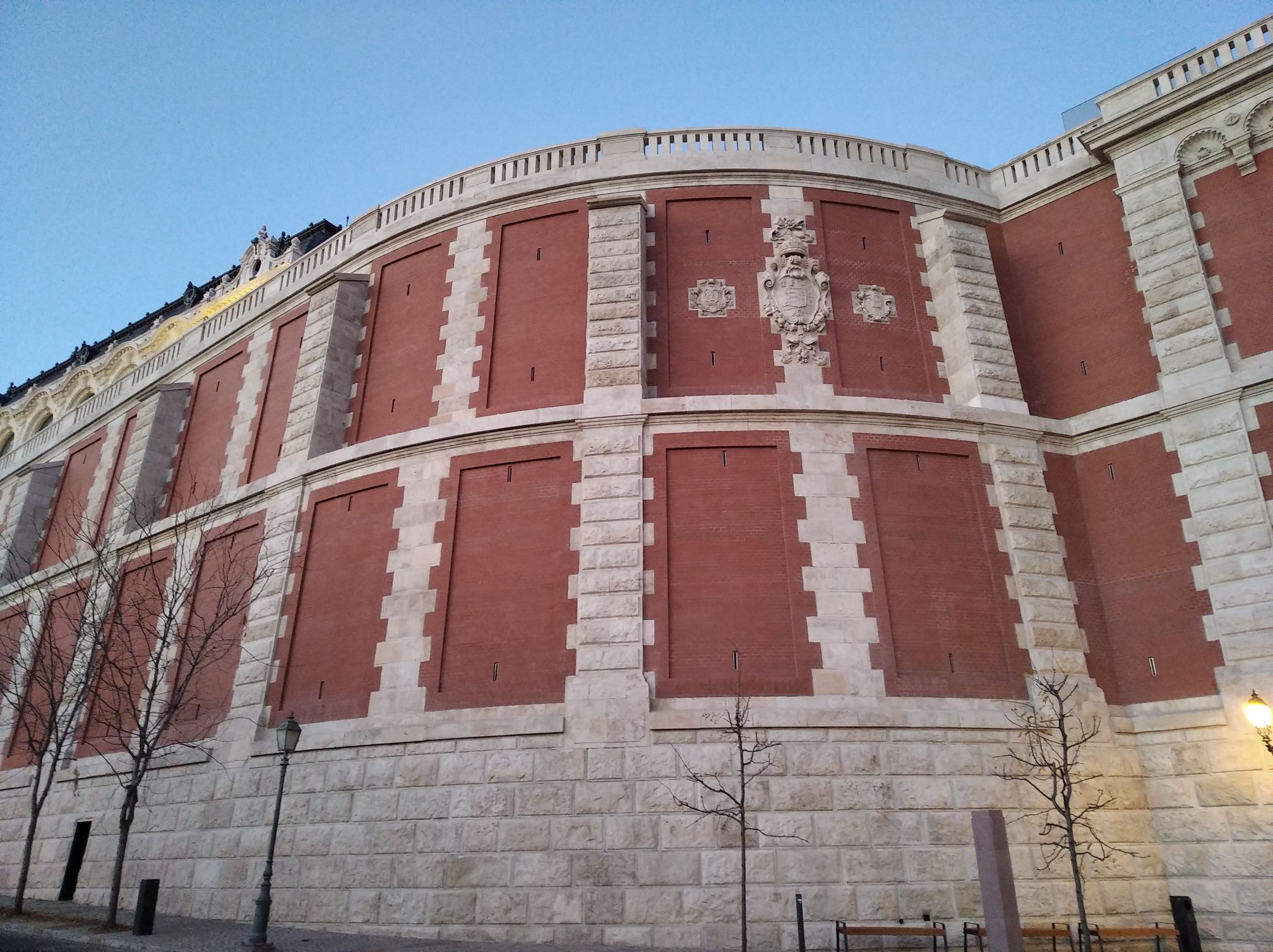
The renovated, ornate retaining wall looks great under the Riding Hall (Photo: Péter Bodó / pestbuda.hu)
To the east, the court is bordered by the brick-covered castle wall itself, the surface of which is divided by huge but quite flat niches. Doors and windows open next to the Royal Guard, and the walled strips holding the arches of the booths are filled with military-themed reliefs. The promenade, which starts from Dísz Square and is built at the top of the castle wall, turns into a low-slope ramp here and leads you down to the level of the court by making a sudden turn-off at the Royal Guard.
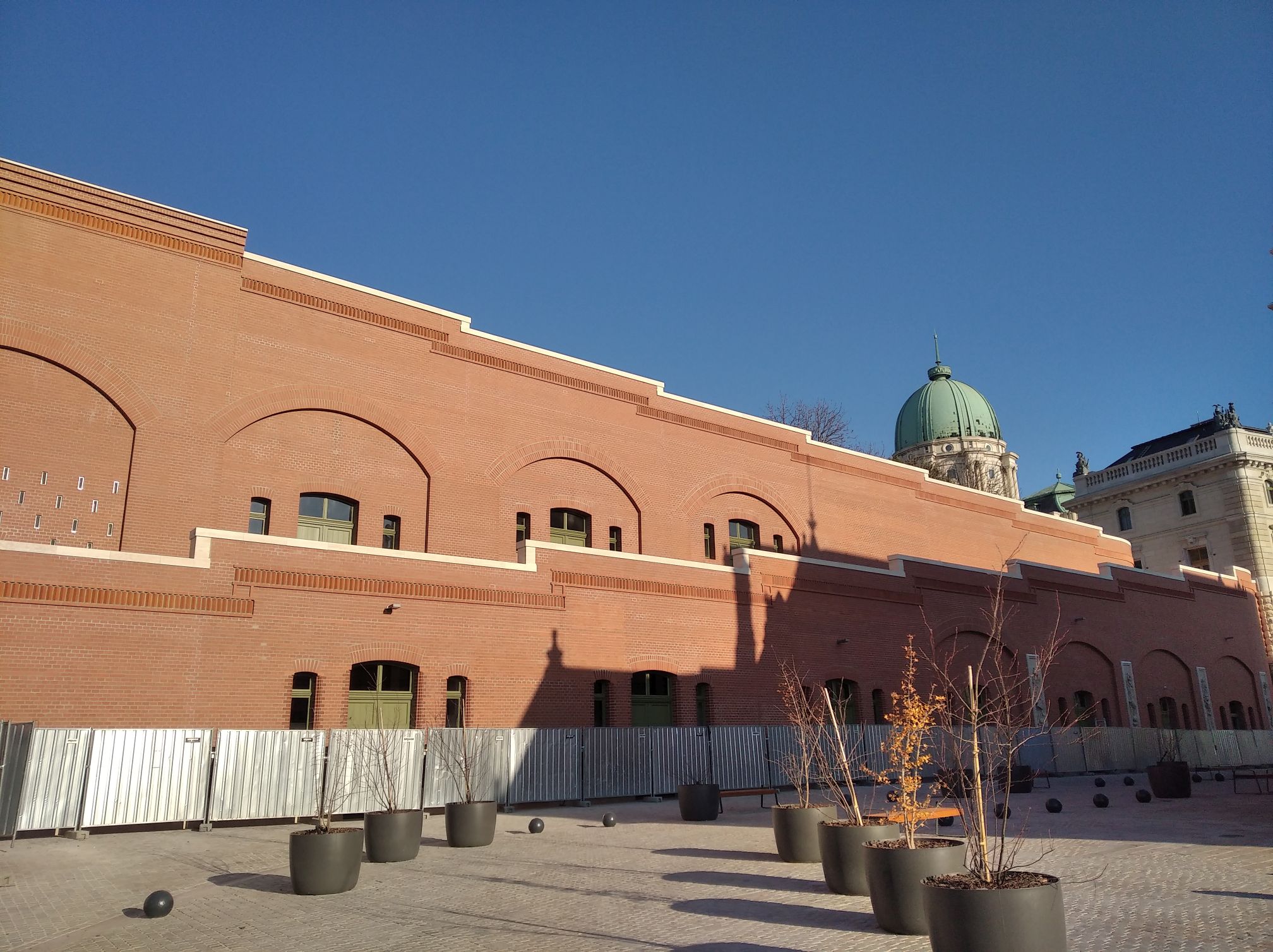
In the Csikós Court, the castle wall is covered with bricks, which also serves as a ramp (Photo: Péter Bodó / pestbuda.hu)
Thanks to the achievements of modern technology, the court can be reached by the heavy-duty elevators (33 people) next to the National Széchényi Library. Also in line with the needs of the 21st century, baffle spheres separating the roadway and sidewalk, as well as bicycle racks, were placed in the cobbled court. Next to the Riding Hall, a well provides refreshing water, which will be very useful in the summer heat. These comfort improvements are made of modern material, in a modern design, indicating that they do not belong to the original equipment of the yard.
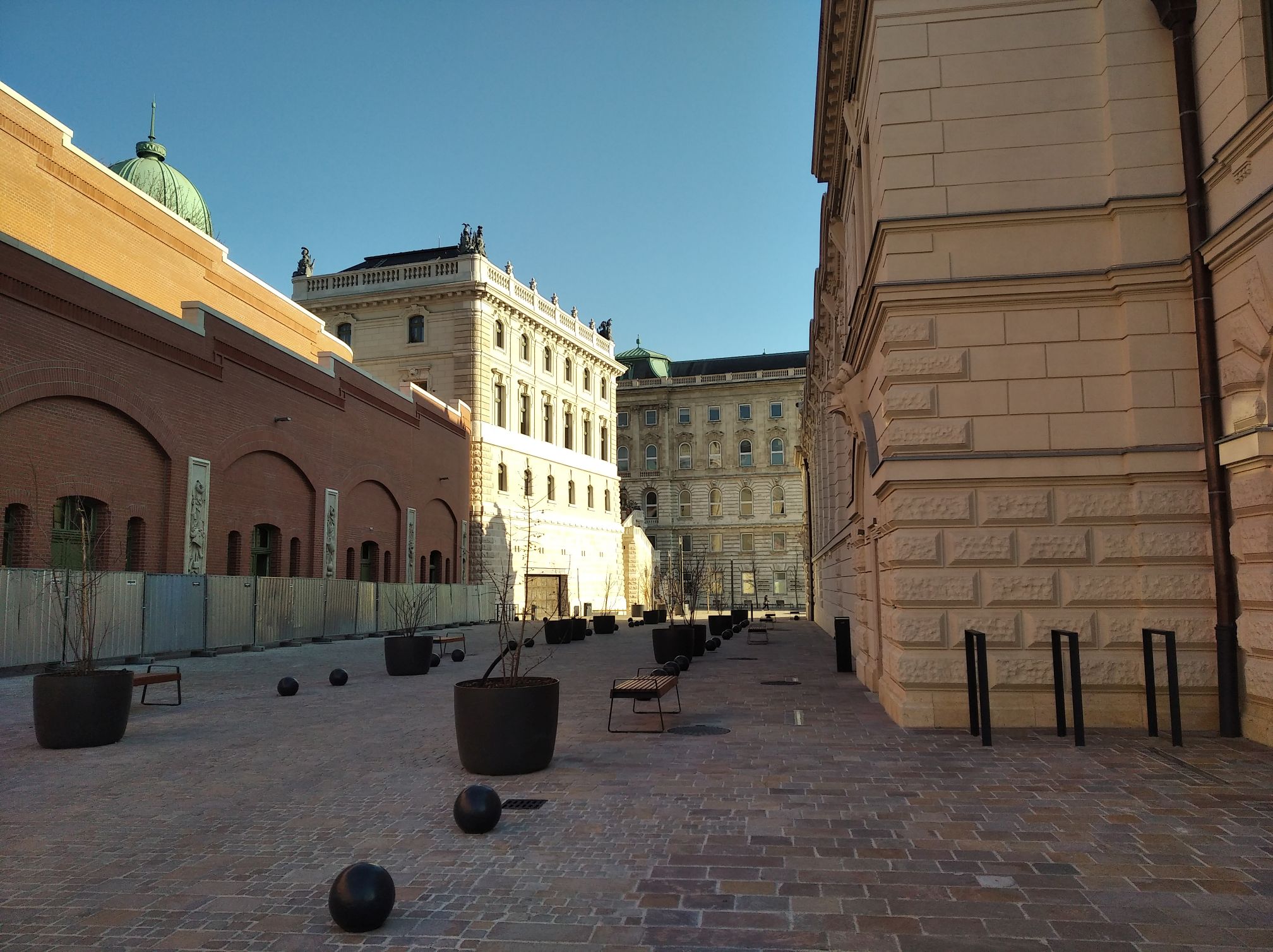
In the Csikós Court, the castle wall is covered with bricks, which also serves as a ramp (Photo: Péter Bodó / pestbuda.hu)
Thanks to the achievements of modern technology, the court can be reached by the heavy-duty elevators (33 people) next to the National Széchényi Library. Also in line with the needs of the 21st century, baffle spheres separating the roadway and sidewalk, as well as bicycle racks, were placed in the cobbled court. Next to the Riding Hall, a well provides refreshing water, which will be very useful in the summer heat. These comfort improvements are made of modern material, in a modern design, indicating that they do not belong to the original equipment of the yard.

Huge relief decorating the entrance to the underground archaeological space (Photo: Péter Bodó / pestbuda.hu)
Thanks to the Stöckl Stairs, completed in 1896, we can get directly from the Csikós Court to the Hunyadi Court, which is already the foyer of the Royal Palace. More than a staircase: it is integrated into the neighbouring building of the Royal Guard and there is an entrance to this building at the bottom and at the top. Its Neo-Renaissance façade has also been adapted to this building by its designer, so it is covered with so-called quadrangular stones carved regularly, and the corners are reinforced with more rustic stones. Being trapped in a very small area, it leads up to the top of the upper castle wall, which is also paved with quadrangular stones, by making several turns.
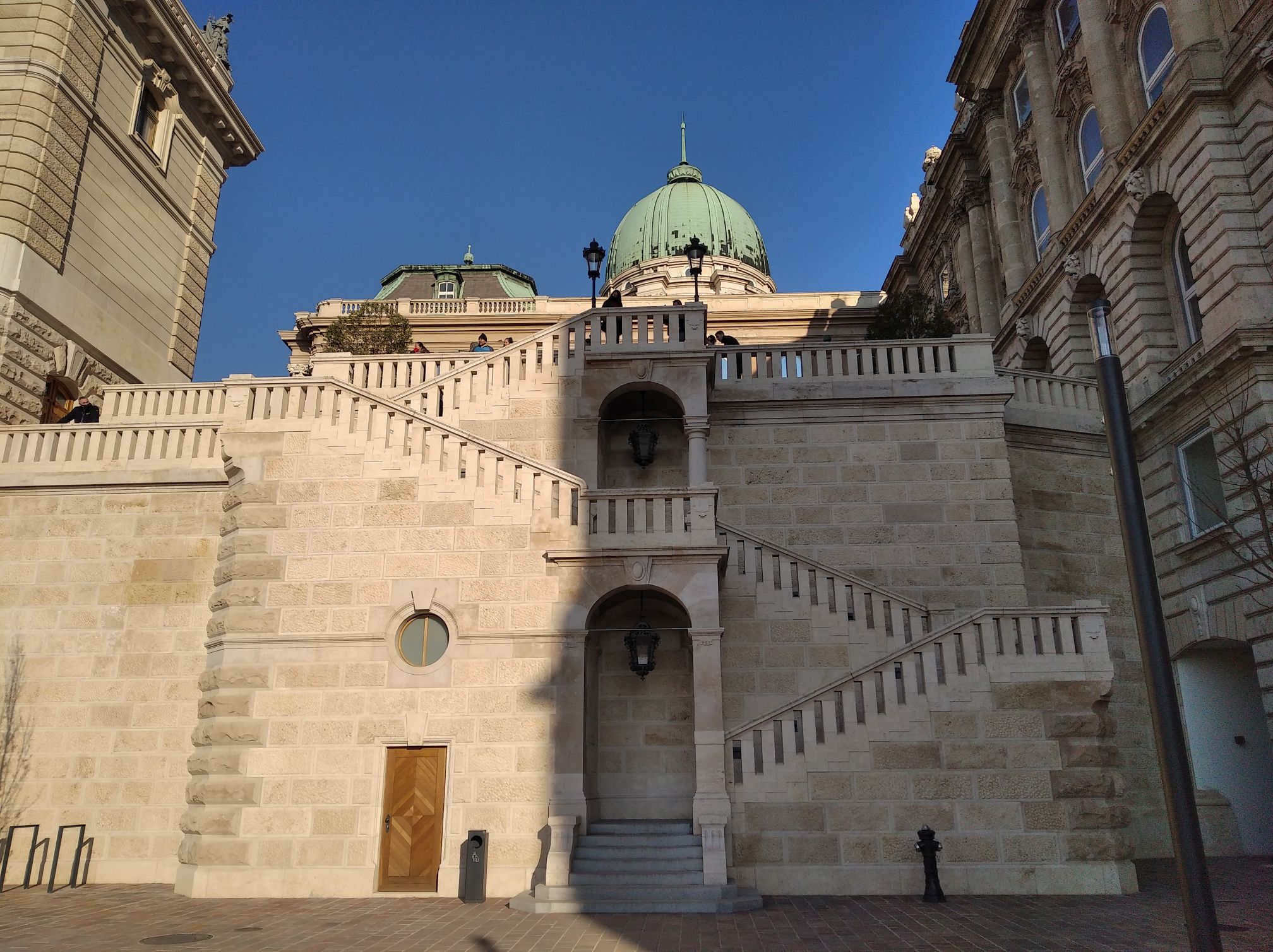
The Stöckl staircase was integrated with both the castle wall and the Royal Guard (Photo: Péter Bodó / pestbuda.hu)
It attracts passers-by with a progressive section of a few steps bounded on two sides by a dwarf fence. It is as if we are entering a gate: above us rises an arch with a basket-arched closure, which is adorned with a keystone with an oval appliqué (cartoise) on top, and on the right side rests on a graceful pillar. Crossing the gate, we get to a rest area, which is lit by a decorative lamp hanging from the vault. The resting place also turns the direction of the stairs at right angle.
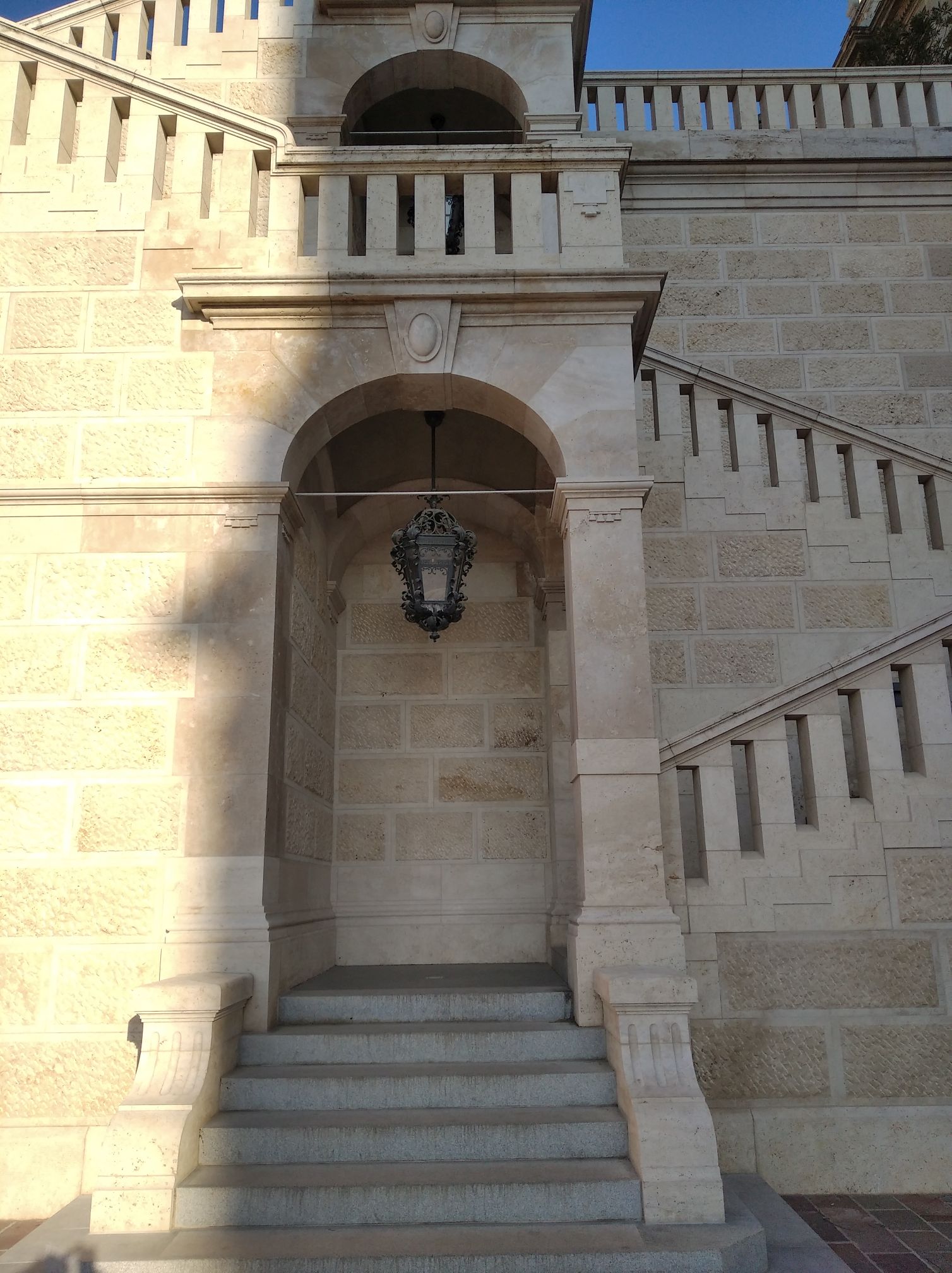
The front of the stairs looks like a gate that invites you to enter (Photo: Péter Bodó / pestbuda.hu)
This is where the stairs, about a meter and a half wide, actually start, accompanied by a low railing of dwarf pillars. This is a late 19th-century paraphrase of Renaissance puppet railings, a good indication that it was made in the Neo-Styles era. The steps themselves are comfortable to walk on, they don’t rise steeply, so we can easily get to the next rest. Here the route turns back 180 degrees, and then the next rest at the top of the next flight of stairs is already covered by a vault. It stands exactly above the gate and its arches are the same as the one below, although here they do not rely on a pillar but on a column with a low Tuscan capital.
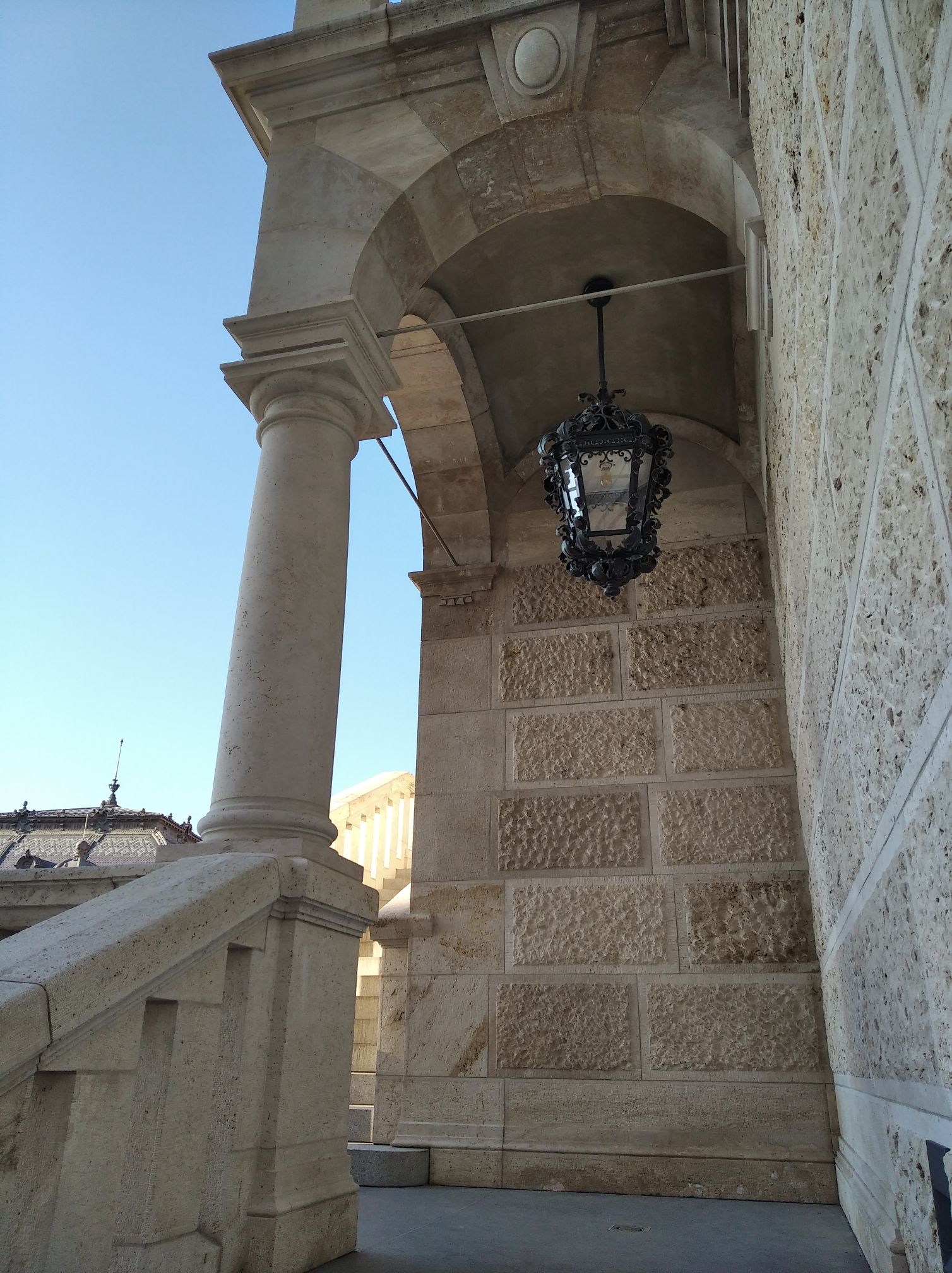
The vaulted lounge upstairs is one of the most beautiful parts of the stairs (Photo: Péter Bodó / pestbuda.hu)
From here we step out onto a smaller terrace so that completing the next step, a larger terrace will be our next stop. This may mean the end of our journey, as the upstairs door of the Royal Guard building is located here. But if our goal is Hunyadi Court, we don't have to walk much anymore. The stairs end at the top with a smaller terrace, the parapet of which continues to the top of the castle wall. As it has the same design as the railing below, it encloses the building in a nice frame, of course it also has an important function, it protects people from falling.
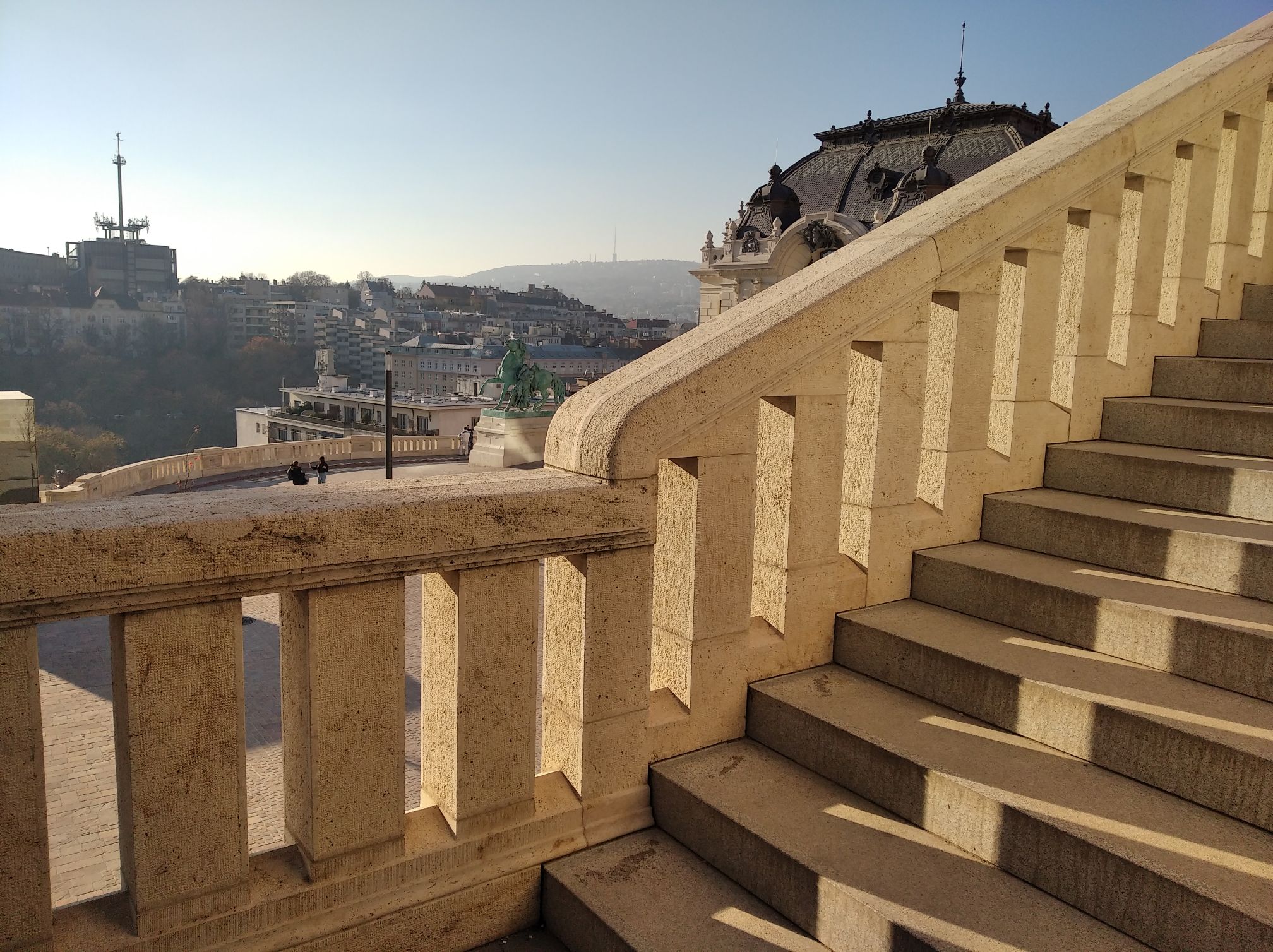
The pillars of the stair railing are lined up densely but in good rhythm (Photo: Péter Bodó / pestbuda.hu)
In its heyday, the staircase was certainly used by the country’s top dignitaries, but its fate turned bad after World War II. It was barely damaged during the siege, but since the Csikós Court was practically closed, it was also disused. Finally, in 1971, it was demolished along with the Royal Guard building to make the sheer castle wall visible in its place. However, after nearly half a century, it was rebuilt to serve those who sought the Castle again. The former Royal Palace now houses high-quality exhibitions thanks to the cultural institutions that operate in them. It is worth going up through the Csikós Court and the Stöckl Stairs to have a more complete aesthetic experience.
Cover photo: The Riding Hall and the Csikós Court in the Buda Castle (Photo: MTI / Lajos Soós)

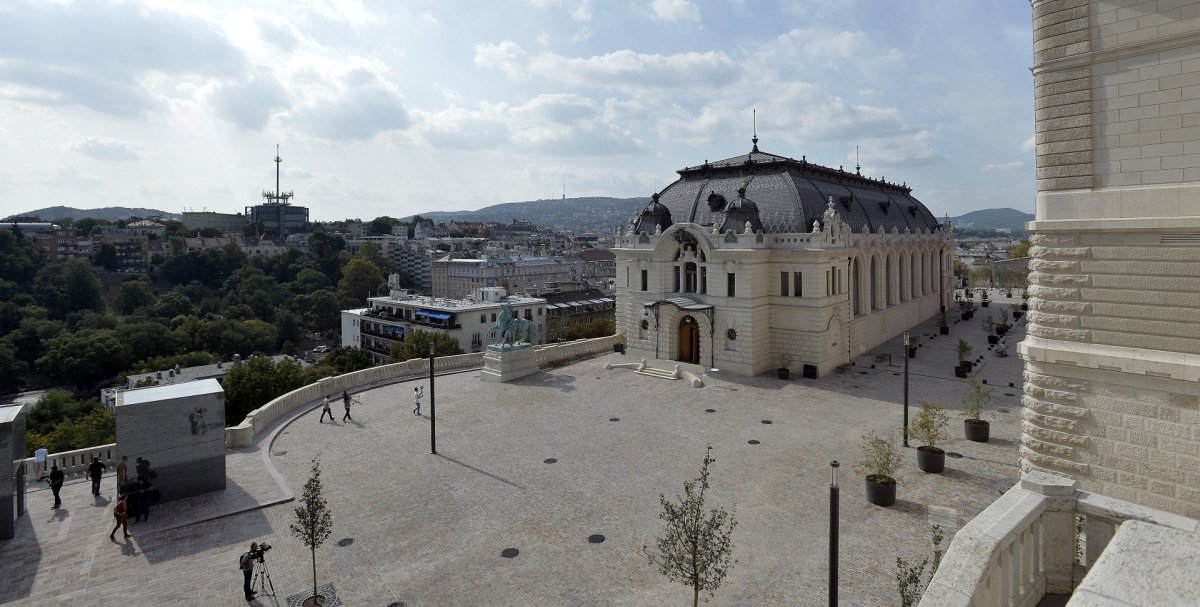


































Hozzászólások
Log in or register to comment!
Login Registration